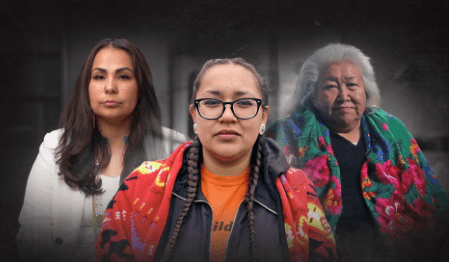
ARTICLES December 2, 2023, CBCNews “Why weren’t we believed?’
Allegations of sexual assault against actor Nathan Chasing Horse were made as early as 2009 in Alberta. Charges were filed against him in the U.S. earlier this year, while women in three Canadian provinces have come forward with similar allegations.
By Mark Kelley, Ivan Angelovski, Ronna Syed Dec. 2, 2023
Nicole Big Crow lets out a deep breath. She fidgets nervously, twisting a tissue into knots. She wants to share a story she’s kept secret for years. About the damage that was done to her years ago when a medicine man came to town.
Big Crow is 30 years old. She grew up on the Tsuut’ina Nation, a community of about 3,000 southwest of Calgary. A place where she thought she was safe.
Big Crow filed an application days ago with the Alberta Court of Justice to have a publication ban revoked in a case involving her so she could be named in this story.
“It’s been a nervous day. It’s really scary because the story’s going to be out there,“ she told The Fifth Estate’s Mark Kelley.
“I’m just glad that people will finally know who he actually is. And that’s a predator who preys on young girls. “
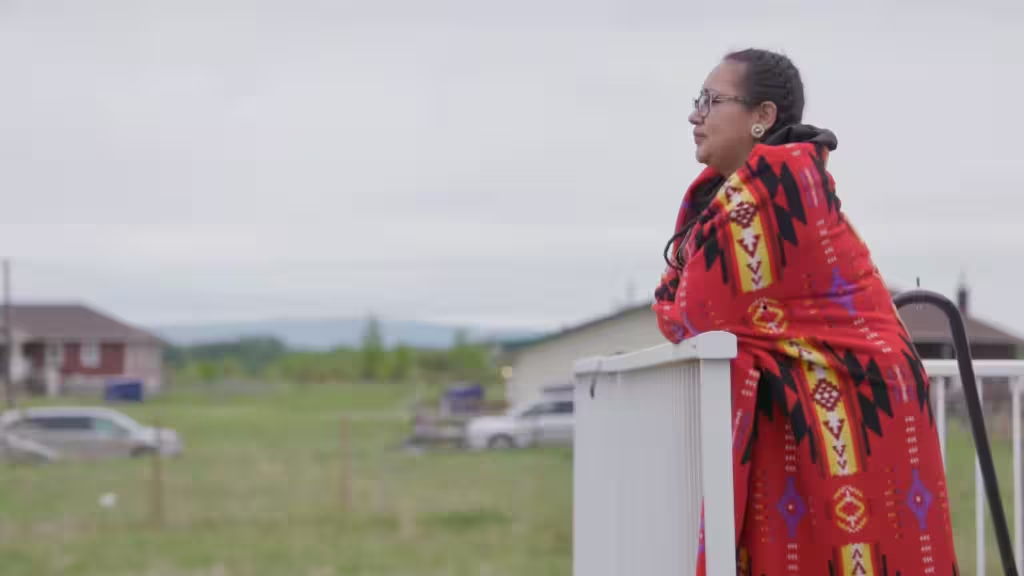
The man she considers a predator is Nathan Chasing Horse. In January, Las Vegas police arrested him. The 47-year-old is facing 18 charges, including 10 counts of sexual assault with a minor under the age of 16, six counts of sexual assault and one count of kidnapping a minor.
Those charges stem from complaints made by two women living in the United States. One of them says she was 14 when she was first sexually assaulted by Chasing Horse.
He has pleaded not guilty to all charges. Chasing Horse says the sex was consensual, and not a crime.
Las Vegas police also allege he is the leader of a cult called The Circle. It is believed at the time of his arrest, he was living with seven women he considered his “wives.” According to the arrest report, some claim they were violently beaten by him and forced to have sex with other men. Some of the alleged sexual assaults, police say, were recorded on his phone.
While Chasing Horse faces those charges in the U.S., women in three Canadian provinces have also come forward, claiming they were sexually assaulted by him, an investigation by The Fifth Estate has found.
And given that one woman filed a complaint against Chasing Horse with the Tsuut’ina police in 2009, a question for many remains regarding why it took police so long in Canada to investigate him.
I. Who is Nathan Chasing Horse?
Nathan Lee Chasing His Horse was born in 1976 on the Rosebud Indian Reservation in South Dakota, a member of the Sicangu band of the Lakota Sioux.
But his life would be transformed after he was cast as the Lakota boy Smiles a Lot in the 1990 Kevin Costner movie Dances With Wolves. Chasing Horse says he was just 11 years old when he learned about the casting call for the film.
“Kevin Costner had an open cast call over here, in Mission, South Dakota, at the college,” he said in a 2010 radio interview. “And I went. And my life has never been the same since then.“

Dances With Wolves is a story of a U.S. Civil War-era soldier posted to the American frontier who is eventually embraced by the Lakota Sioux. The film grossed $424 million worldwide and won a staggering seven Oscars in 1991, including best picture.
“Dances with Wolves changed the way Western society looks at Native Americans,” Chasing Horse said in that 2010 interview.
“It opened up a lot of opportunities for Native Americans throughout the world, you know, throughout the country. So Dances with Wolves … it’s a history maker and I was very fortunate and blessed to be a part of that.”
That led to roles in movies, television series and increased his profile as he travelled to schools and Indigenous communities in the U.S. to talk about his success. He was billed as a “spiritual Sioux” in one 1992 newspaper article, urging students to say no to drugs and alcohol and encouraging Indigenous youth to be proud of their culture and identity.
His father, Joseph Chasing Horse, told a newspaper his son was the great-great grandson of the renowned Lakota chief Crazy Horse, and thought he could also be the fulfilment of an ancient Lakota prophecy of a spiritual healer, or medicine man, sent to heal Lakota people after the trauma of colonization.
“It’s because of my culture, I have to be straight and be a nice person,” Nathan Chasing Horse told The Press in Evansville, Ind., in 1991. “My dad and my grandads tell me I have to be a role model.”
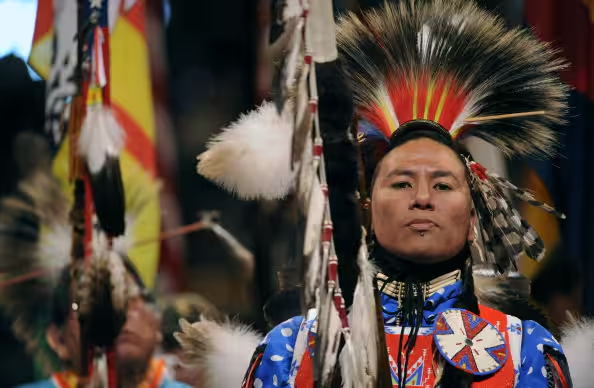
Lee Crowchild, a former chief of the Tsuut’ina Nation, said medicine people are traditional healers and ceremonial leaders who are believed to hold the gift to enable them to communicate with the spirits of ancestors to help with physical ailments, similar to prayer circles.
“Prayer is really important to keeping us grounded, to the identity of who we are. This is where medicine people come in. Some of them can talk with spirit. Some of those can actually deal with the emotional needs of people,“ said Crowchild.
For the last two decades, Chasing Horse has travelled what’s called the Pow Wow trail, holding healing ceremonies from the U.S. southwest and up into Canada — from B.C. to Manitoba.
As a self-proclaimed healer, he was drawing people to him who were broken and vulnerable.
LISTEN | Nathan Chasing Horse takes part in a podcast:
Tala Tootoosis remembers meeting him at a pow wow in Saskatchewan in 2011. She was a dancer who took part in competitions at pow wows, community celebrations held across North America. She was 28, a struggling single mother, when Chasing Horse approached her.
“He follows the old ways, you know, he’s a medicine man and he’s also a movie star, and it was all very peculiar considering the fact that most medicine people are quite humble, quiet, to themselves, and hidden,” she told The Fifth Estate.
“The way he carried himself was what you would see in an anime kids’ cartoon like a prince. Very charismatic.”
Asked if she thought Chasing Horse took advantage of his position, Tootoosis replied: “Absolutely. I think that was his major MO.”
Tootoosis took a selfie of them together dressed in ceremonial dance regalia. She tagged it “Me and Nate. Best friends forever.” And “Sweetest man I ever met.”
They are words that would come back to haunt her.
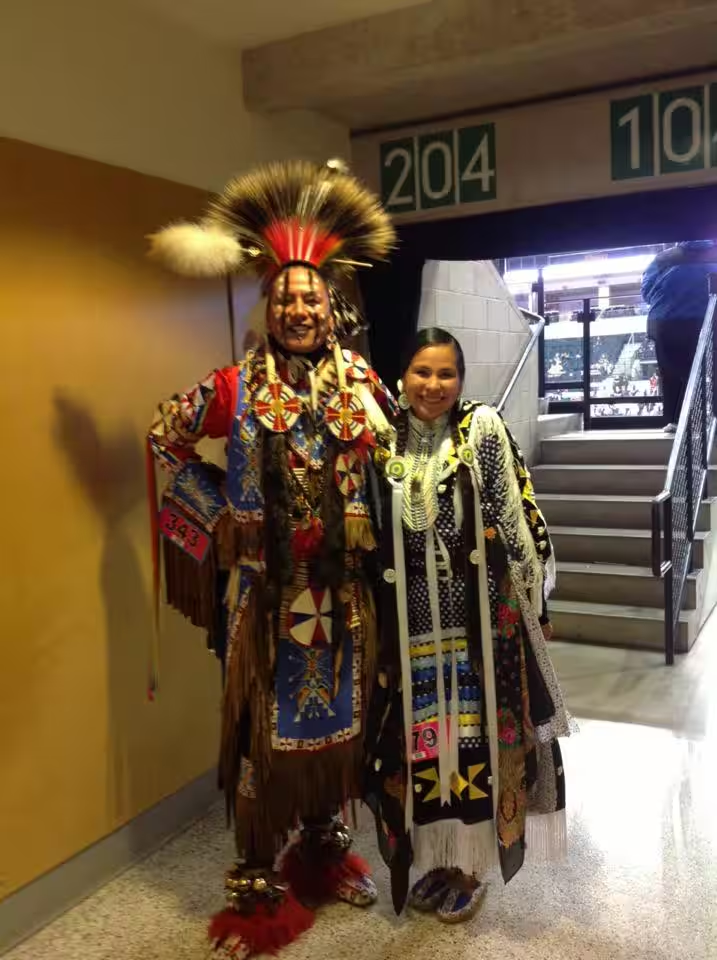
II. The Pow Wow trail
By 2006, Nathan Chasing Horse was an established actor, a self-proclaimed medicine man and a fixture at pow wows across North America. One of his helpers told the Press Democrat, a newspaper in Santa Rosa, Calif., that they travelled 100,000 kilometres a year attending pow wows and holding spiritual ceremonies.
A role in a movie brought him to Tsuut’ina Nation in 2006. He had a part in the made-for-TV adaptation of the Dee Brown book Bury My Heart At Wounded Knee.
Marina Crane, a 71-year-old elder from Tsuut’ina, was working as a Lakota dialect coach on set.
“On the movie set, he made himself aloof. He’ll be sitting there and you know everything’s going on and he’d just [be] like: ‘You come to me, I’m not going to come to you and find out who you are,’“ she said.
WATCH | Recalling an introduction to the community:
Chasing Horse also arrived in Tsuut’ina with an entourage — several men who were his helpers for his healing ceremonies. Crane said she encouraged people in Tsuut’ina to attend, thinking it would be beneficial for the spirit of the community to reconnect with their cultural traditions.
“Every time they had a ceremony, Nathan charged $5,000, so I had to lobby the chief and council for money. Now I’m typing up papers. I’m doing research. So I emailed the people where he had been working, asking for references, and nobody in the States followed through, nobody.”
That was just the beginning of concerns that were raised at the time about Chasing Horse.
Pamela Bird, who had moved to Tsuut’ina after she married a member of the band council, remembers meeting Chasing Horse in 2008. Both she and her husband had children from previous relationships. Her husband was paying Chasing Horse to hold a ceremony at their house to help strengthen the bond of their blended families.
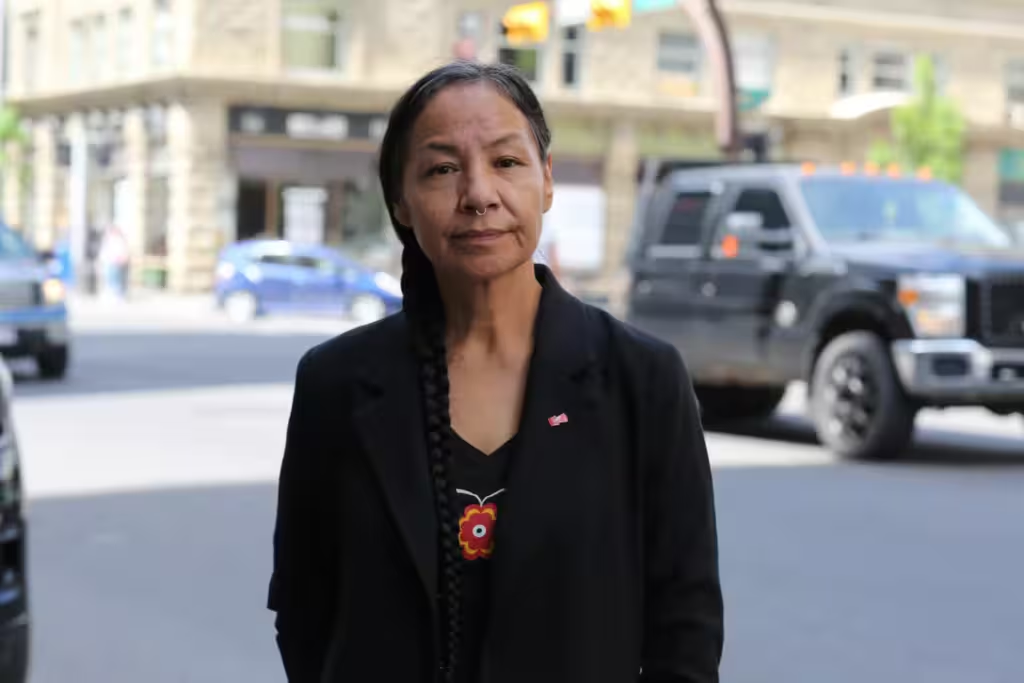
“First impression? Is that a pimp? For real. He had on these rings. And this big fur coat. And a big fur coat in summer. Maybe he did it intentionally, to dress like that? But I was like, wow. That’s a medicine man,” Bird said.
Bird is a survivor of the Sixties Scoop. She grew up in foster care with a non-Indigenous family. She said her childhood was marred by alcohol, violence and sexual abuse.
“It made me afraid. I lived in fear the majority of my life.”
She hoped a medicine man could heal her trauma.
She remembers a ceremony at their house. Her life would never be the same.
“When the ceremony was over, just a whole lot of stuff was going on in there … rattles and lights. And this beautiful show … I was just amazed by it. How beautiful. I want to be a part of this.”
Bird would spend the next 13 years of her life as a member of The Circle, moving from Edmonton to live with other members in houses in Las Vegas. Bird recently left the group and moved back to Canada. She has never shared her story publicly before.
When asked if she feels The Circle is a cult, she didn’t hesitate.
“Yes. Because when you gather women and you gather men and you brainwash them? That’s not spirituality. And you knowingly live off their fear. And you knowingly take their money. And you knowingly threaten them. That’s a cult. Big time.”
Bird says Chasing Horse portrayed himself as a saviour who could control spirits to help, or hurt people in The Circle. Other members said Chasing Horse told them harm would come to their families if they ever betrayed him and left The Circle.
III. The Circle
The house on Shockwave Court in North Las Vegas is pretty unremarkable. From the outside, at least.
The suburban community is just a 20-minute drive from the Vegas Strip, but seems like a world away from the glitz and glamour of Sin City.
Nathan Chasing Horse had been living in the home for years, although when contacted by reporters, neighbours said they didn’t know who lived in the house.
That quiet anonymity was shattered when the SWAT team from the Las Vegas Metropolitan Police raided the home on the night of Jan. 31.
Police say at the time of the raid, Chasing Horse shared the house with five women he called his “wives.”
They found a loaded long rifle inside the house, as well as three 9-mm handguns.
According to allegations in the Las Vegas police report, Chasing Horse had taught the women how to use the firearms in the event of a police raid so they could “shoot it out.”
The report also claims he had instructed the women to take “suicide pills” if law enforcement tried to break the family apart.
For years, Chasing Horse had been building that family, the women that he took as wives and the men who were there to serve him, working as helpers during his travelling ceremonies.
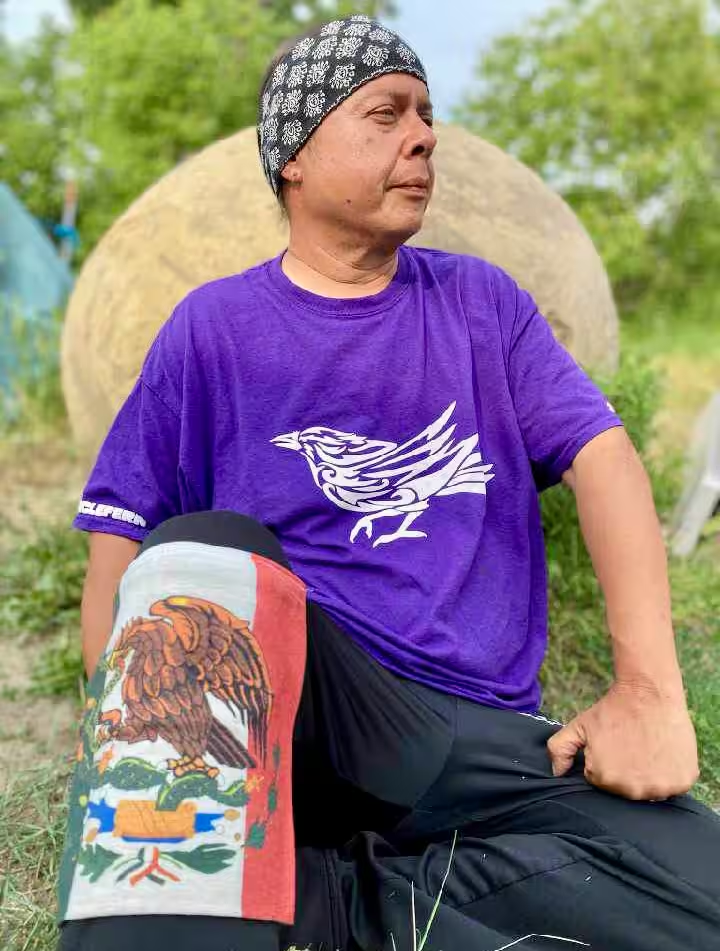
Fernando Trujillo was a key member. He was drawn to the spiritual teachings of the Lakota. He started attending sweat lodges and sundances in Pinon, Ariz. That’s how he met Chasing Horse.
“There were good times when I first started going to the ceremonies. I was really appreciative, in a place I wanted to be spiritually.“
In 2006, he started travelling with Chasing Horse.
“I was singing in ceremonies — it’s the most important part of the ceremony. You need those songs because they are very powerful. Also, when we have sweat lodges, I would carry the stones, clean the sweat lodge area and serve him, basically.”
That gave Trujillo a front row seat for what was going on inside The Circle. And he became increasingly disturbed by what he saw.
“He wasn’t with multiple wives when I met him. He gradually started to obtain them,“ said Trujillo, who spent eight years in The Circle.
“He eventually had seven wives. But we couldn’t look at them. He said we would go blind if we looked at them. We believed him.”
Chasing Horse made the women wear bells so the men would know when they were approaching and look away. But over the years, Trujillo said, he would get glimpses of the women.
“Sometimes I would accidentally see them, and they had black eyes. I never saw him hit them, but I heard him verbally abuse them,” he told The Fifth Estate.
One of the “wives” told her story on Facebook live in 2022. Her name is Corena Leone. Her mother was a member of The Circle, and Leone said she would accompany her to ceremonies with Chasing Horse when she was just six years old.
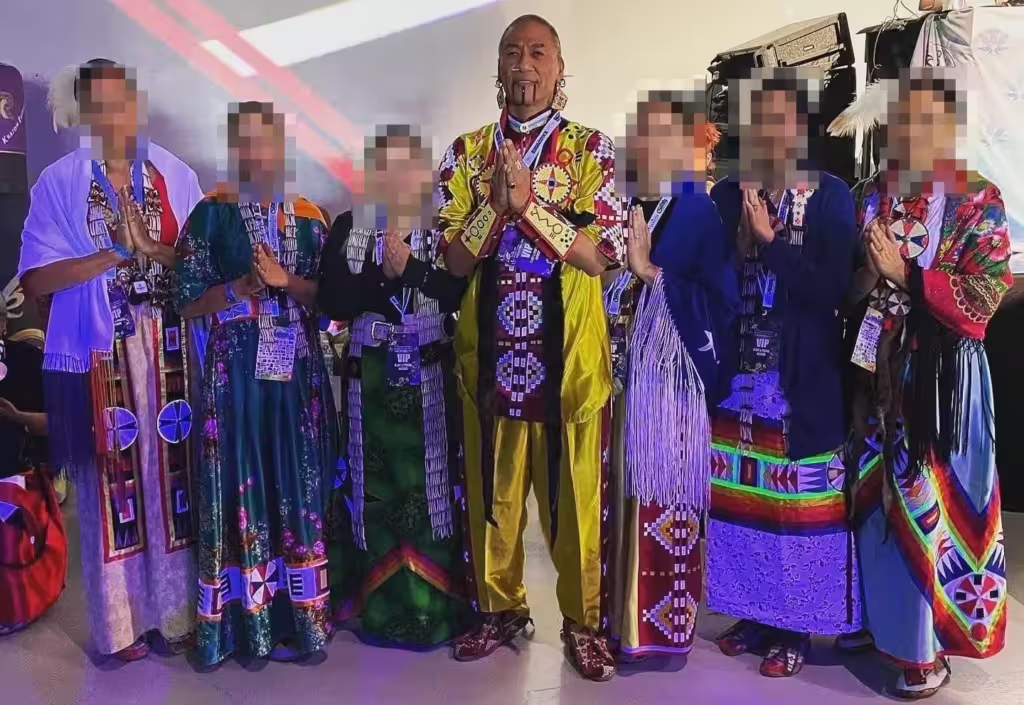
She would refer to him as grandfather as a show of respect. When she was 14, her mother was diagnosed with Stage 4 cancer. She dispatched her daughter to Las Vegas to see Chasing Horse and ask if he would treat her. She said Chasing Horse told her he needed to consult the spirits, or grandfathers, as he called them.
“And so he took me into this closet, and he had the spirits come in and say that the cost to help my mother was higher than most because my mom struggled with so much mentally that she would have a hard time changing. And that’s how cancer was created in her body, and that if the price wasn’t high enough, she would get sick again.“
Leone said she and her mother were living in a homeless shelter at that time, so she felt she had little to offer the medicine man. But she said he told her she did have one thing to give. Her virginity.
“And I tried saying no to the virginity the first time, but the spirits said that it was the last pure thing about me. And they said a lot of things about me that made me feel pressure, like it was the only thing I could give that was worth something.”
Leone said Chasing Horse sexually assaulted her in a closet.
“It happened there in that closet the first time. And from then on, it just kept happening.”
Leone spent six years with Chasing Horse as one of his wives.
“We had to prove our love to him. And it was a weird brainwashing kind of thing. We were told it was an honour to love him. “
Chasing Horse travelled to ceremonies with his multiple wives. He had to purchase a second vehicle in order to accommodate them. Trujillo said Chasing Horse regularly asked members of The Circle for money. Some made monthly payments.
“He’s an actor, and he would play a role,“ said Trujillo. “He would call people and say that we didn’t eat for days, we were hungry, and people would start making collections — thousands of dollars.”
Pamela Bird heard those appeals for money. She answered them time and time again.
“I thought, if that’s what they live on, then maybe we should just give a little bit more? It got to the point where I gave him a couple of cars. Hundreds of thousands of dollars,” which she gave over the decade she spent with The Circle.
The Circle served Chasing Horse well. Until it all started to fall apart as more and more women broke their silence.
IV. Breaking the silence
Nicole Big Crow was one of the first to break her silence. It was 2008. The teenager from Tsuut’ina remembers hearing a celebrity medicine man was in her community. She went to a healing ceremony at her aunt’s house given by Chasing Horse. He later spoke to students at her high school. She was in Grade 9. That’s where Big Crow says she first approached Chasing Horse.
“I was interested in more ceremonies and sweats. I was proud of my culture. So I asked him if he had any more sweats that he was doing, and he said yes and he said give me a call and I got his number. That’s how it started.”
Big Crow has never publicly shared her story outside her family and friends before. But she felt speaking out would encourage other women to come forward with their stories of abuse at the hands of Chasing Horse.
“I did text him, and then he said that he’d take me [to a ceremony]. And I told my mom. She said it was OK. I told him it’s OK, and then he showed up, here in my house. And then we drove away and where he was supposed to go he didn’t go left, he went right.”
Big Crow says Chasing Horse took her to a trail in a secluded spot in Tsuut’ina and sexually assaulted her. She was 15. She said that was the first of three assaults. She would keep it a secret for a year, until she confided in her mother.
“I think she felt ashamed and guilty that it was her fault,“ her mother, Deanna Big Crow, told The Fifth Estate. Big Crow said she “freaked out” and told her husband, who suggested they go to the police.
WATCH | Speaking out to encourage others to come forward:
John Pace, Nicole’s stepfather, was an officer with the Tsuut’ina police.
In 2009, Nicole Big Crow gave a statement to another officer on the force. She said she was hoping the police would arrest Chasing Horse, but she says she was told there was nothing the police could do.
“Nothing, because there’s not enough evidence. Because the officer asked if I had any used clothing from the time, and I said no, they were already washed, it was too late.”
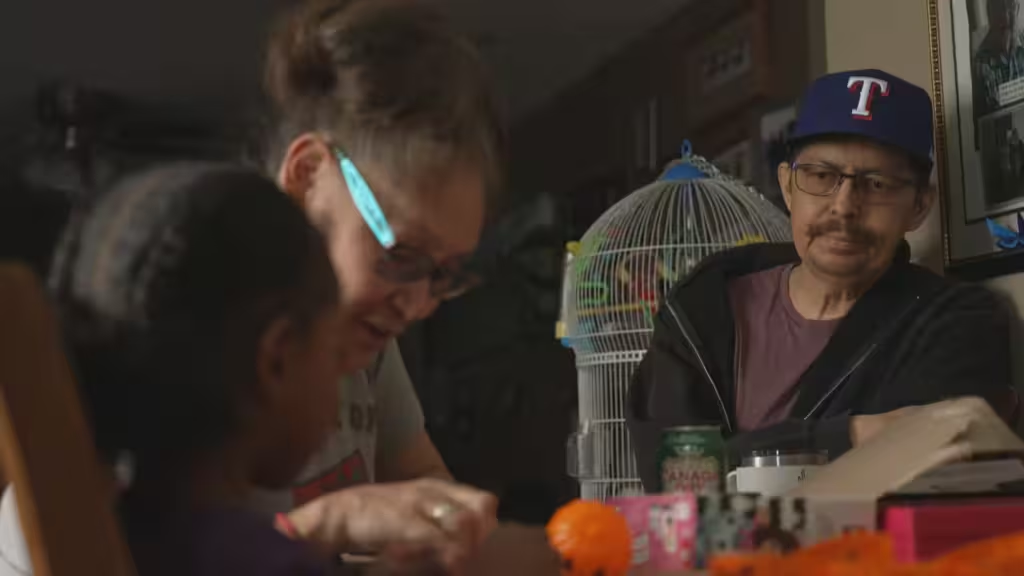
She said the inaction of the Tsuut’ina police left her feeling even more vulnerable.
“Just defeated, I guess. Somewhat ashamed. Still do.”
But whispers started growing in Tsuut’ina about Chasing Horse and other teenage girls.
Marina Crane, an elder and activist from the community, said she had seen Chasing Horse spending time with her 15-year-old stepniece, Roberta. In 2011, Crane published a blog called “I finally spoke to her,” after she says she confronted Roberta about rumours on the reserve.
“About four years ago, a holy man, or so his followers called him, came into my community. She told me this man, I will call him NCH, slept with her. She was 15 at the time…. My stepniece said he told her he loved her and that he didn’t have sex with his other girlfriends because he only had sex with her. It gets worse; he also had sex with three other 15-year-olds.”
Crane wanted her blog to be a warning to other women, other girls. She felt Chasing Horse was a predator who needed to be stopped. But she said nobody in authority was listening.
“Because it wasn’t happening here. And I know because it wasn’t happening here it would be the same in other First Nations. It’s not just Tsuut’ina. Because the supporters of him were suppressing any kind of dialogue that women would have,“ said Crane.
Chief Lee Crowchild says at that time, Chasing Horse had supporters on the band council in Tsuut’ina.
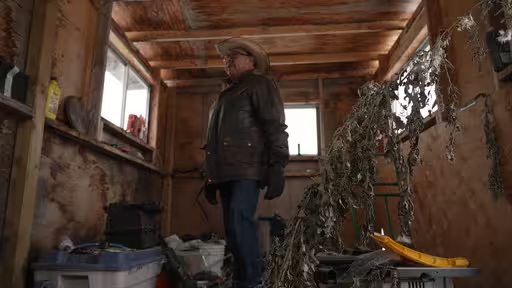
“They were saying we should be thankful this guy is in our community. You know, don’t embarrass us. This is a famous man,” said Crowchild.
That support began to evaporate. Chasing Horse would eventually be banned from the Tsuut’ina Nation. But that wasn’t until 2015. The band council issued a resolution, which claimed he was a danger to the community after repeated complaints.
That same year, Chasing Horse was banned by the Federation of Sovereign Indigenous Nations from attending pow wows in Saskatchewan following a complaint by Tala Tootoosis.
Tootoosis said Chasing Horse sexually assaulted her. She filed a complaint with the Saskatoon police in 2015. She says she wasn’t called back by police and nothing came of it.
“We told our story, we weren’t believed. Why weren’t we believed? How deep is that ingrained in our society? How many times do we go to the police, and we tell them our story, and nobody calls us back? said Tootoosis.
In 2015, Chasing Horse was also banned from the Fort Peck Indian Reservation in Montana. The Fort Peck Journal said the ban was based on allegations of human trafficking, drug dealing, spiritual abuse and intimidation of tribal members.
In 2018, the RCMP in Keremeos, B.C., received a sexual complaint about Chasing Horse. But once again, no action was taken against Chasing Horse.
It would be another eight years before Chasing Horse would be arrested in Las Vegas.
V. The reckoning
Chasing Horse made his first appearance in the Clark County District courtroom in Las Vegas in February.
He was dressed in a blue prison jumpsuit and handcuffed.
Marina Crane hadn’t seen Chasing Horse in years. But when she saw a picture of him online, she felt no pity for the man sitting in the prisoner’s dock in Las Vegas.
“Well, he’s quite ugly. And very thin. When I saw him, I thought how he looks and how he appears, he deserves all of that. He deserves all the hate that people are projecting to him. In fact, all that hate doesn’t even amount … to the hurt and pain that he’s inflicted on so many girls and so many women.”
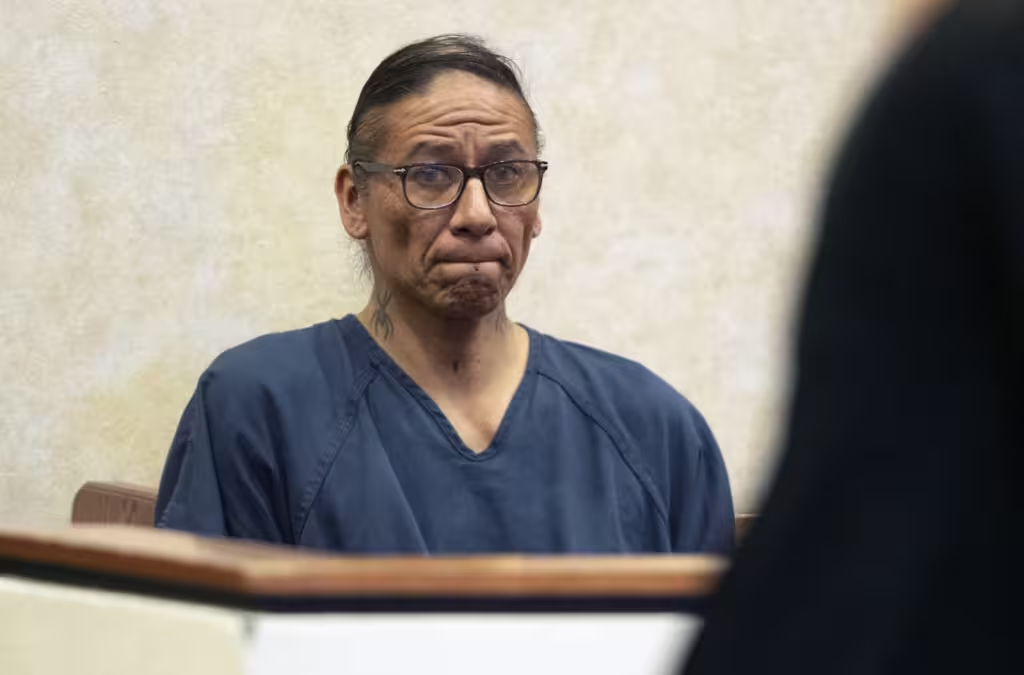
Chasing Horse has pleaded not guilty to the 18 charges against him. They stem from two women who filed complaints against him in the US.
His court-appointed lawyer, Kristy Holston, has not denied Chasing Horse had sex with those women.
But she told the Clark County District Court the sex was consensual, given as an offering for Chasing Horse’s services as a medicine man.
“Sex for a transactional purpose is not sex assault. I’m asking the court to dismiss the entire case,” Holtson told the court.
The trial is on hold after she filed an appeal with the Nevada Supreme Court to dismiss the case. The appeal was heard on Nov. 15. Several members of The Circle, including some of Chasing Horse’s “wives,” attended the hearing.
While he may still have supporters, the charges against Chasing Horse continue to grow. The FBI has filed federal charges in Nevada, two counts of sexual exploitation of children and one count of possession of child pornography.
The tribal court in Fort Peck, Mo., has issued a warrant for his arrest for sexual assault of a child.
And last June, police in Tsuut’ina Nation announced nine charges against Chasing Horse, including sexual exploitation, sexual assault and removing a child from Canada under the age of 16. Those charges involve three women, including Nicole Big Crow.
While sources say Chasing Horse may never be extradited to Canada to face those charges, Big Crow takes some comfort in the fact he is in custody in Las Vegas.
“I felt good, I was hoping he gets life or something. He deserves it. There’s too many girls out there. I’m not the only one, obviously. There’s many stories out there,“ she said.
But Big Crow’s story dates back to 2008. So why did it take so long for charges to be laid against Chasing Horse?
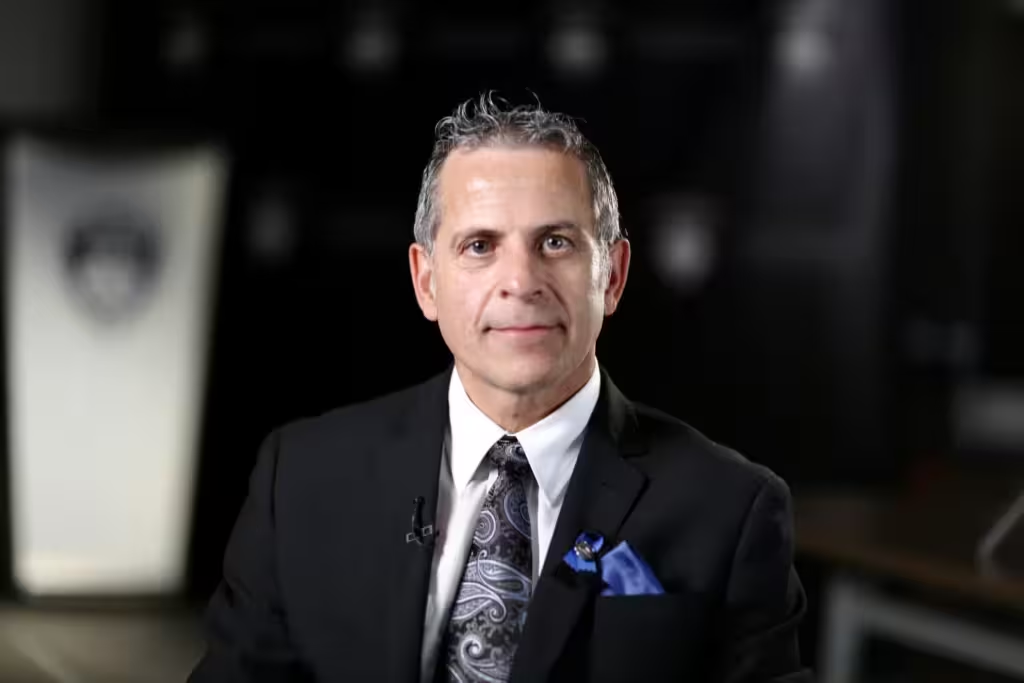
Cpl. Michael Cavilla is a veteran of two decades of policing in Calgary. He recently joined the Tsuut’ina Nation Police Service as investigation co-ordinator.
“There are similar types of complaints right across B.C., Alberta and Saskatchewan, where single complainants have come forward over the years. And then those files have sat dormant, gone cold, if you will,” said Cavilla.
“And so when it’s a ‘he said, she said’ type situation and there’s no other corroborating evidence, sometimes police investigators are hesitant to pursue a charge with the Crown,” said Cavilla.
He said communication between police jurisdictions on both sides of the border has improved over the years, but admits it may have come too late for some of the women who say they were assaulted by Chasing Horse.
“That’s the way this file went. It’s unfortunate because in the aftermath of that there was a swath of victims in Western Canada, in the western United States, as a result of him not being locked up sooner. “
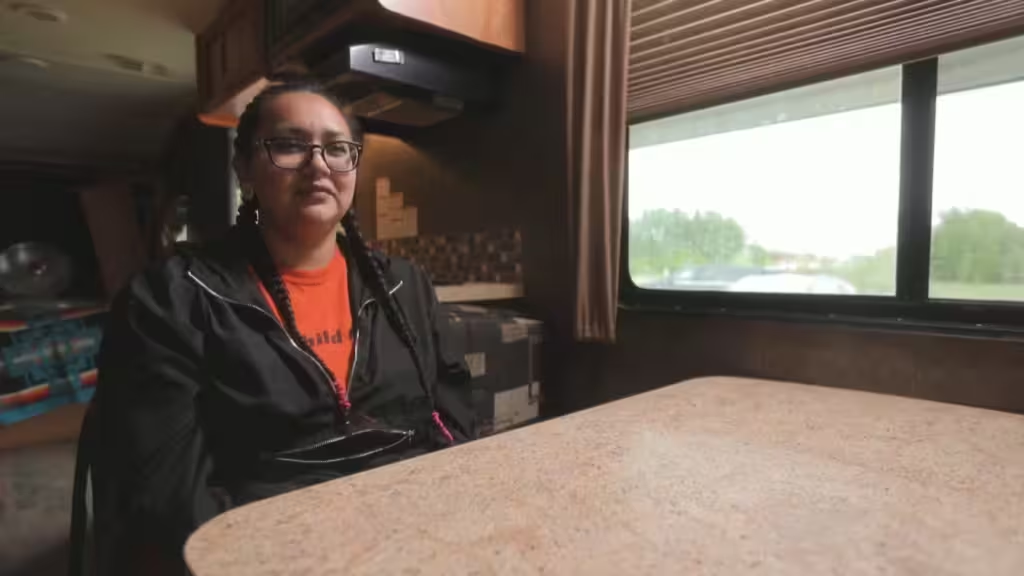
Nicole Big Crow is relieved she’s shared her story after all these years because she believes there are many more survivors out there who haven’t come forward yet and may follow her lead to file charges.
“At first, I didn’t want to do it, I didn’t want to do this, but I was hoping that this will make them stronger as well. I really hope they know that.”
She wants to send a message that breaking your silence is an act of defiance and a show of strength, especially as the mother of three young daughters under 10 years of age.
“I just want to protect them at all times. I hope that I give them enough wisdom about men, and predators, and I hope I can protect them from that.”